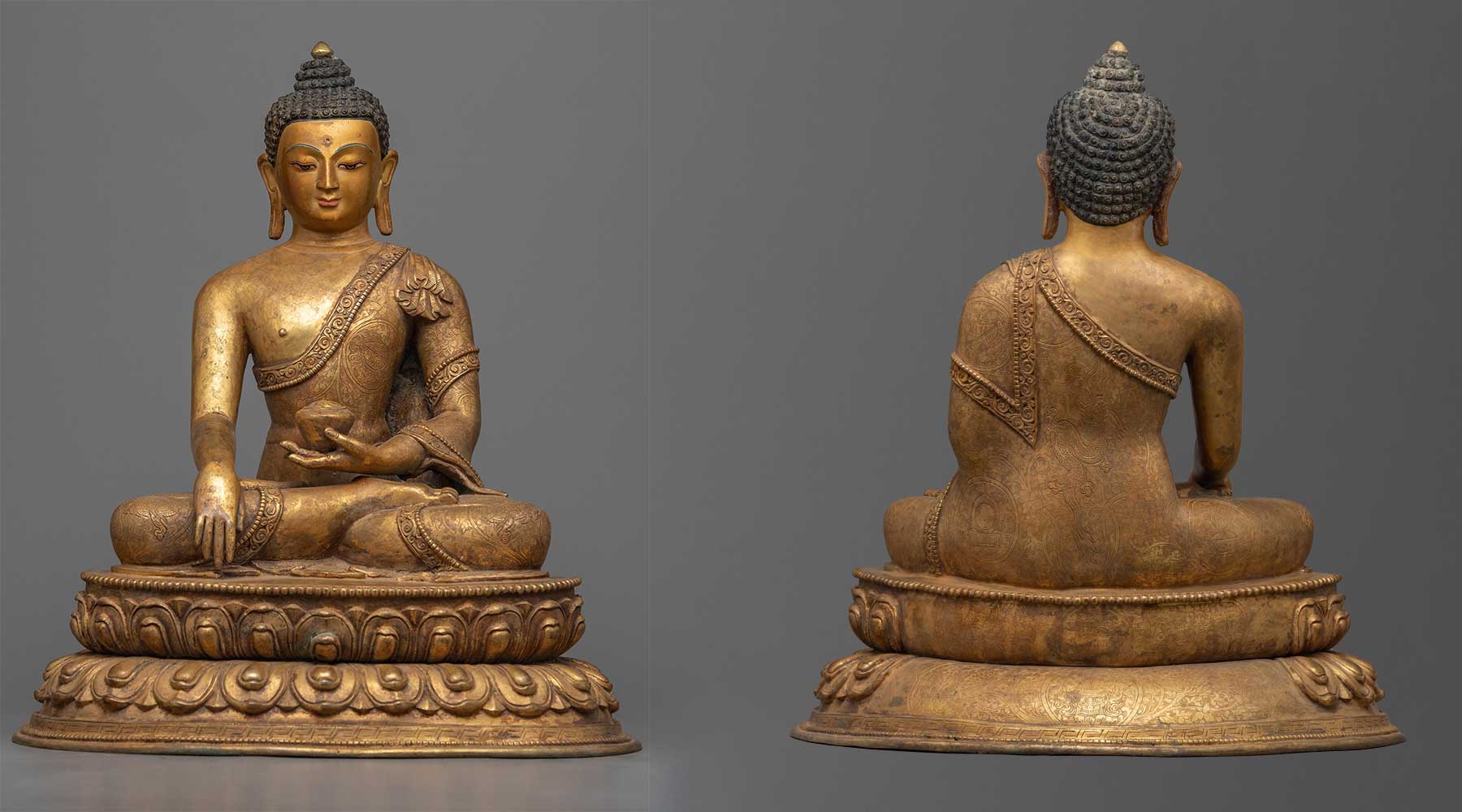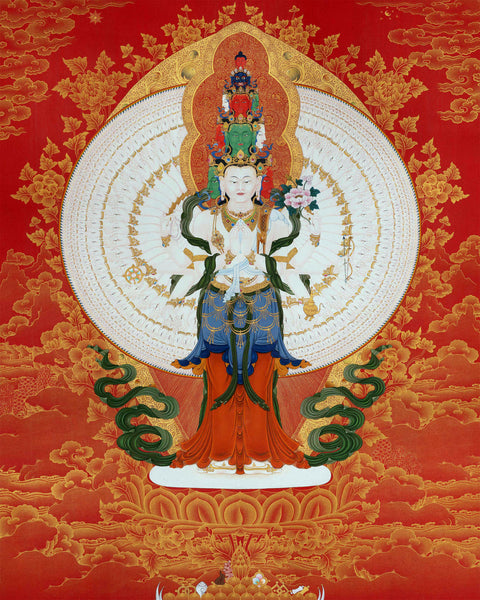Buddha & Bodhisattva: A Journey of Enlightenment
The knowledge of Buddhism, religion, and philosophy based on the teachings of Siddhartha Gautama, the Buddha, is fundamentally based on the spiritual concepts of Buddha and Bodhisattva. They both refer to distinct pathways and states of being in the Buddhist tradition, even though they are interrelated and reflect the same qualities of compassion and enlightenment.
Key Takeaways
- The term "Buddha" refers to an enlightened being who has gained Nirvana and realized the truth of existence, freeing oneself from the cycle of birth and death.
- A bodhisattva is a being spurred on by immense compassion and spontaneously desires to become enlightened to serve all sentient beings. They postpone their enlightenment to assist others.
- In contrast to Buddhas, who stand for achieving enlightenment and liberation, Bodhisattvas represent selflessness and a never-ending quest to enlighten others.
Historical Background
Click here to view our Buddha Statue Collection
The Buddha, also known as Siddhartha Gautama, set out on a transforming journey and gave up worldly pleasures to discover the meaning of life. His attainment of enlightenment beneath the Bodhi tree marked the beginning of Buddhism and illuminated the road to freedom from suffering.
As Buddhism developed, the idea of Bodhisattvas originated, representing beings who, inspired by compassion, strive to become Buddhas for the good of all sentient beings. These enlightened beings personify the Mahayana tradition's selfless core.
Philosophical Foundations
The Four Noble Truths, which explain the nature of suffering, its causes, its cessation, and the way to its end, are the focal points of the Buddha's teachings. These principles are the cornerstone of Buddhist philosophy and lead practitioners to enlightenment.
The Bodhisattva path revolves around Bodhicitta, the awakened mind. It is the impulsive desire to become enlightened from a deep love and compassion for others. The distinguishing quality of a Bodhisattva is this benevolent desire.
What is the difference between a Buddha and a Bodhisattva?
- Buddha: The Enlightened One
An individual who has gained full enlightenment and comprehends the fundamental essence of existence is referred to as a Buddha. A Buddha has transcended the cycle of birth, death, and reincarnation (samsara), freeing them from all impurities and suffering.
Siddhartha Gautama, the founder of Buddhism, is the most well-known Buddha. However, Buddhism acknowledges the existence of numerous Buddhas, each manifested in various epochs and realms. The Sanskrit term buddh, from which the English word "Buddha" is derived, means "one who is awake."
- Bodhisattva: The Compassionate Being
A bodhisattva is a being who has cultivated the spontaneous desire (Bodhicitta) to become a Buddha for the good of all sentient beings. A Bodhisattva decides to put off their ultimate enlightenment to help others by staying in the cycle of existence. They perfect the cultivation of virtues, called paramitas, such as kindness, ethics, patience, effort, focus, and wisdom.
The terms bodhi and sattva combine to form the word Bodhisattva. Bodhi signifies complete wisdom or knowledge. It is direct, pure, and universal knowledge. 'Sattva' is a mental state in which one's thoughts are stable, quiet, and peaceful, and one's thoughts, words, and actions are coordinated to uphold this mental state.
| Aspect | Buddha | Bodhisattva |
| Definition | An enlightened being who has attained Nirvana. | A being aspiring to attain Buddhahood for the sake of others. |
| Goal | Liberation from samsara | Alleviation of all beings' suffering. |
| Characteristics | Wisdom, compassion, and purity. | Alleviation of all beings' suffering. |
| Stage | The last step toward liberation from the circle of life, death, rebirth, and realization of reality. | Prior Stage of Becoming Buddha |
The Path of a Buddha
- Attainment of Enlightenment
The quest and realization of total enlightenment define a Buddha's path. Realizing the Four Noble Truths—the truth of suffering, the truth of its source, the truth of its resolution, and the truth of the way to that resolution—is a necessary step in this process. Buddhists liberate themselves from all ignorance and attachments by realizing all phenomena' transient and non-self nature.
- Teaching the Dharma
A Buddha seeks to spread the Dharma, or universal truth, after achieving enlightenment to show others the way to liberation. The sutras, or teachings of the Buddha, help sentient beings develop moral behavior, mental discipline, and knowledge. They also help them grasp the nature of life.
The Path of a Bodhisattva

- Generation of Bodhicitta
The formation of Bodhicitta, or the mind of enlightenment, is the first step on the path of a Bodhisattva. Becoming a Buddha is a spontaneous, unrestricted desire motivated by enormous compassion and love for all beings. The distinguishing quality of a Bodhisattva is this benevolent desire.
- Cultivation of Paramitas
A Bodhisattva practices the six paramitas, perfections, to help sentient beings progress towards Buddhahood. These perfections are:
- Dana Paramita: Perfection of generosity.
- Sila Paramita: Perfection of morality.
- Kshanti Paramita: Perfection of patience.
- Virya Paramita: Perfection of effort.
- Dhyana Paramita: Perfection of meditation.
- Prajna Paramita: Perfection of wisdom.
Comparative Analysis Of theses Beings
- Purpose and Motivation
Although Buddha and Bodhisattva seek enlightenment, their goals and methods differ. A Bodhisattva, driven by selflessness, swears to remain in samsara until all beings are freed, unlike a Buddha, who attains enlightenment and spreads the Dharma to help creatures out of suffering.
- Role and Activity
Bodhisattvas actively participate in compassionate deeds to help beings on their spiritual paths, while Buddhas serve as instructors, illuminating the path to liberation. The Bodhisattva's path is characterized by unceasing labor and numerous deeds of generosity, kindness, and selflessness.
The Dharma, which Buddhas shared to enlighten the way to liberation, serves as their spiritual teachings. They offer a path to enlightenment that enables beings to overcome suffering and recognize their innate Buddha nature.
Bodhisattvas must lessen suffering for all beings. They practice compassion and exemplify the Mahayana tradition's spirit of altruism by helping and encouraging others in their quest for enlightenment.
How does a Bodhisattva become a Buddha?
One will learn that the path of the Bodhisattva is all about waking and achieving a life pattern that is the Human embodiment of "Buddha" when you read the sutras, especially the Mahayana sutras. Buddha is a mental state that can be encountered as a person (Bodhisattva). For this reason, Bodhisattva has been particular about the degrees or depth of awakening in the sutras, commonly known as the Buddha path.
"A Buddha is thus an awakened being, a realized being who knows the truth of reality while Bodhisattva is an individual striving to achieve the state of Buddha and to become a Buddh or Buddha."
The "Bodhisattva" path is also known as striving to realize our "Buddha" potential ultimately. Since its inception, every study on Buddhism has been focused on revealing what is already true but obscured by the avarice of the human mental state.
As a student or monks, we may strengthen our perceptions and sharpen our awareness of the enlightenment around us when we set out on a focused course of study. As this consciousness grows, we eventually "dwell" in Buddhahood by being that awareness intellectually and physically.
The many facets of Buddhism require a grasp of the ideas of Buddha and Bodhisattva. The Bodhisattva stands for the selfless path of ongoing compassion and service to others, whereas the Buddha represents the height of enlightenment and the conclusion of the spiritual journey.
Both approaches enrich the Buddhist tradition and provide a variety of paths for achieving spiritual development and realization, each with its reasons and expressions.

